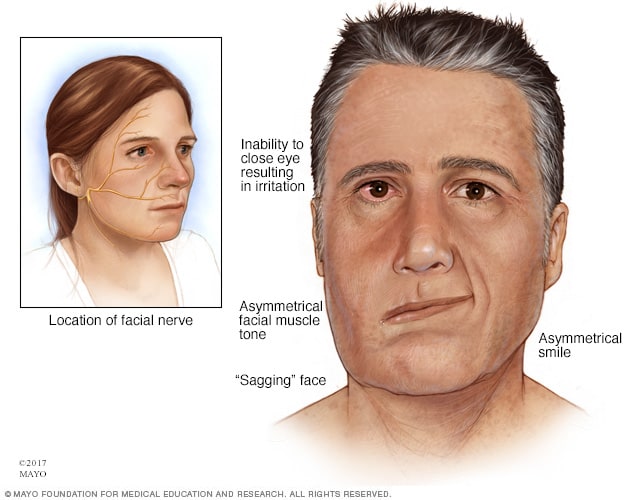Overview
Bell's palsy is a condition that causes sudden weakness in the muscles on one side of the face. In most cases, the weakness is temporary and significantly improves over weeks. The weakness makes half of the face appear to droop. Smiles are one-sided, and the eye on the affected side resists closing.
Bell's palsy is also known as acute peripheral facial palsy of unknown cause. It can occur at any age. The exact cause is unknown. Experts think it's caused by swelling and inflammation of the nerve that controls the muscles on one side of the face. It could be caused by a reaction that occurs after a viral infection.
Symptoms usually start to improve within a few weeks, with complete recovery in about six months. A small number of people continue to have some Bell's palsy symptoms for life. Rarely, Bell's palsy occurs more than once.
Products & Services
Symptoms
Facial paralysis

Facial paralysis
The nerve that controls your facial muscles passes through a narrow corridor of bone on its way to your face. Facial weakness or paralysis may cause one corner of your mouth to droop, and you may have trouble retaining saliva on that side of your mouth. The condition may also make it difficult to close the eye on the affected side of your face.
Signs and symptoms of Bell's palsy come on suddenly and may include:
- Rapid onset of mild weakness to total paralysis on one side of your face — occurring within hours to days
- Facial droop and difficulty making facial expressions, such as closing your eye or smiling
- Drooling
- Pain around the jaw or in or behind your ear on the affected side
- Increased sensitivity to sound on the affected side
- Headache
- A loss of taste
- Changes in the amount of tears and saliva you produce
In rare cases, Bell's palsy can affect the nerves on both sides of your face.
When to see a doctor
Seek medical help right away if you experience any type of paralysis because you may be having a stroke. Bell's palsy is not caused by a stroke, but it can cause similar symptoms.
If you have facial weakness or drooping, see your health care provider if you have facial weakness or drooping to find out the underlying cause and severity of the illness.
Causes
Although the exact reason Bell's palsy occurs isn't clear, it's often related to having a viral infection. Viruses that have been linked to Bell's palsy include viruses that cause:
- Cold sores and genital herpes (herpes simplex)
- Chickenpox and shingles (herpes zoster)
- Infectious mononucleosis (Epstein-Barr)
- Cytomegalovirus infections
- Respiratory illnesses (adenovirus)
- German measles (rubella)
- Mumps (mumps virus)
- Flu (influenza B)
- Hand-foot-and-mouth disease (coxsackievirus)
The nerve that controls facial muscles passes through a narrow corridor of bone on its way to the face. In Bell's palsy, that nerve becomes inflamed and swollen — usually related to a viral infection. Besides facial muscles, the nerve affects tears, saliva, taste and a small bone in the middle of the ear.
Risk factors
Bell's palsy occurs more often in people who:
- Are pregnant, especially during the third trimester, or who are in the first week after giving birth
- Have an upper respiratory infection, such as the flu or a cold
- Have diabetes
- Have high blood pressure
- Have obesity
Recurrent attacks of Bell's palsy are rare. But when they do recur, there's often a family history of recurrent attacks. This suggests that Bell's palsy might have something to do with your genes.
Complications
A mild case of Bell's palsy typically disappears within a month. Recovery from a more severe case where the face was completely paralyzed can vary. Complications may include:
- Irreversible damage to your facial nerve.
- Irregular regrowth of nerve fibers. This may result in involuntary contraction of certain muscles when you're trying to move other muscles (synkinesis). For example, when you smile, the eye on the affected side may close.
- Partial or complete blindness of the eye that won't close. This is caused by excessive dryness and scratching of the clear protective covering of the eye (cornea).